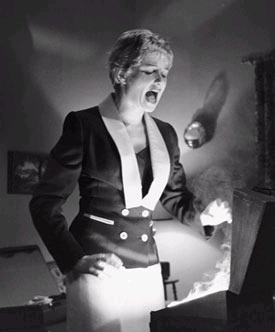Living abroad, basically out of a backpack, prevents one from maintaining the lifestyle of a pack rat. Before splitting from Portland for European lands, my comrade in mischief and I sold off hundreds of books to Powell’s Books. And what they wouldn’t take, we gave away. Although we started packing and getting rid of items a month in advance, the pressure to clear out our cluttered yet pleasantly comfortable apartment was cranked up pretty high those last two weeks. So plenty of books and VHS tapes went to neighbors, acquaintances, and strangers. What we chose to keep–still a good, solid library–got packed up and is supposedly safe and sound in some climate controlled wonderland waiting for us to return one day. My DVDs all went to a friend for safe keeping. No doubt they will be put to good use.
But some of my discs managed to escape being orphaned and are currently accompanying me on my journeys. In the past, when I had traveled “close to the ground,” the thought of having immediate access to films was absurd. And though I would occasionally dream of having films at my disposal, the idea was completely within the realm of science fiction. In the early 1990s, during my first lengthy trip to Europe, I was basically living in a cave. No, seriously. Well, it was a small, unheated one room flat with stone walls and only a wood stove to heat the place. I craved movies, but I craved heat even more. The last time that I was overseas for an extended period of time was 1996, DVDs were still a year away from entering the forum of mainstream acceptability, and therefore the idea of packing a bunch of them with me was ridiculous. I might as well have had access to a jet pack.
Not that I would want to take a traveling case of discs with me anyhow. Traveling, at least the way I’ve always done it, has been about surrendering the comforts of home, relinquishing the familiar, and attempting to reconnect with the alleyways of life.
Anyway, books were more transportable.
Things are different now. Because of work, I have to have access to films, or at least access to the machine that can bring them to life: a laptop. So I brought some with me and it ended up being a perfect opportunity to test out the “desert island” theory of film watching. You’re on a desert island and you can only bring twenty-five films. What films do you bring?
I stowed away a fair bit. Films that would inspire, would sharpen the intellectual batteries, would amuse, would withstand the repeat factor, and would continue to charge the imagination when nothing else would. There was also “homework” to consider, so a few of those ended up with me as well, though most of the required viewing is still back in Oregon awaiting orders to re-enlist for duty.
So what did make the cut? Obvious favorites, to be sure: Seven Samurai, Blade Runner (in all its permutations), Goodbye, Dragon Inn, Le Samurai, Heart of Glass, The Conformist, Curse of the Demon/Night of the Demon, Suspiria, the Sergio Leone westerns, Bad Timing, The Thin Red Line, The Searchers and some other Ford/Wayne westerns, The Wild Bunch, a whole lot of Mario Bava and other European horror films from the 1960s, Barry Lyndon, some Godard, some Truffaut, a couple of Japanese horror films, a couple of samurai films, all of the Val Lewton films, and Lifeforce. Yes, Lifeforce, the craptacular 1985 Tobe Hooper movie. I also tossed in Marcel Carné’s Children of Paradise because I’ve never seen it (an embarrassing admission) and what better time to watch it than when abroad and more likely to have a little time to spare for a 190 minute masterpiece. I’d received the Criterion Collection disc for a review that never panned out and was always waiting for that appropriate rainy day. Well, it took a few years and me having to leave my abode to do it, but I plan on watching it soon.
When planning my exile, I’d expected to watch plenty of films. I purchased a good, compact traveling case and stuffed it with digital goodies. Much to my surprise, my old ways have sort of kicked in again. I haven’t watched much. The first month we were too much on the go, getting acclimated to traveling again. But this last month we’ve been stationary, so we managed to watch The Devil’s Backbone, The Wicker Man (the original 1973 Robin Hardy film not the LaBute/Cage carnival of guffaws) and a couple of nights ago I settled into the Lewton/Robson film The Ghost Ship. More about that last one in a near-future post.
This new, more accommodating style of traveling is weird. I’m not complaining, mind you. But it’s still weird to have the luxury of being seemingly so far from “home,” so far from the familiar and yet be so connected. It’s not exactly like I’m in some mountain retreat at the moment, so I’m not too worked up about it. But it does make me wonder that if I was on a real desert island, I think watching a movie would be the last thing on my “to-do” list.


